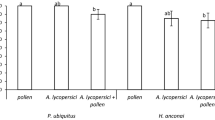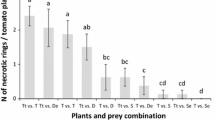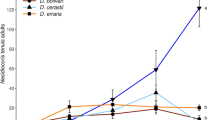Abstract
The predatory mite Phytoseiulus persimilis is frequently reported to perform poorly on greenhouse tomatoes. As the predators are mass-reared on another host plant (bean), we supposed that they are poorly adapted to tomato, a plant densely packed with poisonous and sticky glandular hairs. This hypothesis was tested by comparing the control capacity of a stain of P. persimilis directly obtained from a mass rearing with the same strain after four generations on tomato. Both strains were released in a tomato crop in two identical compartments of a greenhouse and the population dynamics of prey (a tomato strain of Tetranychus urticae) and predator were recorded at weekly time intervals. It was found that the strain previously exposed to a tomato environment performed better than the unexposed strain: (1) its population increased faster; (2) the prey population declined faster; and (3) the damage to new-grown tomato leaves was considerably lower. To investigate the causes of the difference in performance between the exposed and unexposed strains, oviposition and survival rates were assessed on a diet of two-spotted spider mites on tomato leaf sections. In addition, the unexposed strain was tested on a diet of two-spotted spider mites on bean leaf sections. The difference in oviposition rates of both predator strains was small compare to the overall mean. However, the oviposition rate of the first generation of predators since transfer from bean to tomato dropped to less than half of the original value. Moreover, mortality in the first generation increased from 14% to 89%, whereas it decreased to 0% after four generations. Future research should clarify whether these changes in life history are due to selection or to physiological adaptation.
Similar content being viewed by others
REFERENCES
Chatzivasileiadis, E. A. and Sabelis, M. W. 1996. Toxicity of methyl ketone from tomato trichomes to Tetranychus urticae Koch. Exp. Appl. Acarol. 1996 (in press).
Chatzivasileiadis, E. A., Boon, J. J. and Sabelis, M. W. 1996. Accumulation and turnover of 2-tridecanone in Tetranychus urticae Koch and its consequences for resistance of wild and cultivated tomatoes. In: Chatzivasileiadis. E. A., Methyl ketones from tomato: Implications for host races of the phytophagous mite Tetranychus urticae Koch. PhD dissertation, Amsterdam, The Netherlands.
Drukker, B. and Ravensberg, W. 1994. Nieuwe roofmijtstam bestrijdt spint beter. Groenten en Fruit (27 of May): 22–23.
Farrar, R. R. and Kennedy, G. G. 1987. 2-Undecanone, a constituent of the glandular trichomes of Lycopersicon hirsutum f. glabratum: Effects of Heliothis zea and Manduca sexta growth and survival. Entomol. Exp. Appl. 43: 17–23.
French, N., Parr, W. J., Gould, H. J., Williams, J. J. and Simmonds, S. P. 1976. Development of biological methods for the control of Tetranychus urticae on tomatoes using Phytoseiulus persimilis. Ann. Appl. Biol. 83: 177–189.
Gillespie, D. R. and Quiring, D. J. M. 1994. Reproduction and longevity of the predatory mite, Phytoseiulus persimilis (Acari: Phytoseidae) and its prey Tetranychus urticae (Acari: Tetranychidae) on different host plants. J. Entomol. Soc. Brit. Columbia 91: 3–8.
Gotoh, T., Bruin, J. Sabelis, M. W. and Menken, S. B. J. 1993. Host race formation in Tetranychus urticae: genetic differentiation host plant preference and mate choice in a tomato and a cucumber strain. Entomol. Exp. Appl. 68: 171–178.
Hussey, N. W. and Scopes, N. E. A. 1985. Greenhouse vegetables (Brittain). In: Spider Mites, their Biology, Natural Enemies and Control. W. Helle, and M. W. Sabelis (eds.) pp. 285–296. World Crop Pests Vol 1B. Elsevier, Amsterdam.
Janssen, A. and Sabelis, M. W. 1992. Phytoseiid life-histories, local prey dynamics, and strategies for control of tetranychid mites. Exp. Appl. Acarol. 14: 233–250.
Nihoul, P. and Van Impe, G. 1992. Contrôle de Tetranychus urticae au moyen de Phytoseiulus persimilis en culture de tomates sous serre. Med. Fac. Landbouww. Rijksuniv, Gent 56/2a: 319–324.
Nihoul, P. 1992. Effect of temperature and relative humidity on successful control of Tetranychus urticae Koch. by Phytoseiulus persimilis Athias-Henriot (Acari: Tetranychidae, Phytoseidae) in tomato crops under glass house conditions. Med. Fac. Landbouww. Rijksuniv. Gent 57/2a: 949–957.
Sabelis, M. W. and Janssen, A. 1994. Evolution in the life-history patterns of the Phytoseiidae. In: Mites. Ecological and evolutionary analyses of life-history patterns, M. A. Houck (ed.) pp. 70–97. Chapman and Hall, New York.
Roddick, J. G. 1974. The steroidal glycoalkaloid a-tomatine. Phytochemistry 13: 9–25.
Sokal, R. R. and Rohlf, F. J. 1995. Biometry. Freedman, New York.
Stoner, A. K., Frank, J. A. and Gentile, A. G. 1968. The relationship of glandular hairs on tomatoes to spider mite resistance. Proc. Am. Soc. Hort. Sci. 93: 532–538
Van Haren, R. J. F., Steenhuis, M. M. Sabelis, M. W. and De Ponti, O. M. B. 1987. Tomato stem trichomes and dispersal success of Phytoseiulus persimilis relative to its prey Tetranychus urticae. Exp. Appl. Acarol. 3: 115–121.
Williams, W. G., Kennedy, G. G., Yamamoto, R. T., Thacker, J. D. and Bordner, J. 1980. 2-Tridecanone, a naturally occurring insecticide from the wild tomato Lycopersicon hirsutum f. glabratum. Science 207: 888–889.
Author information
Authors and Affiliations
Corresponding author
Rights and permissions
About this article
Cite this article
Drukker, B., Janssen, A., Ravensberg, W. et al. Improved control capacity of the mite predator Phytoseiulus persimilis (Acari: Phytoseiidae) on tomato. Exp Appl Acarol 21, 507–518 (1997). https://doi.org/10.1023/B:APPA.0000018885.35044.c6
Issue Date:
DOI: https://doi.org/10.1023/B:APPA.0000018885.35044.c6




